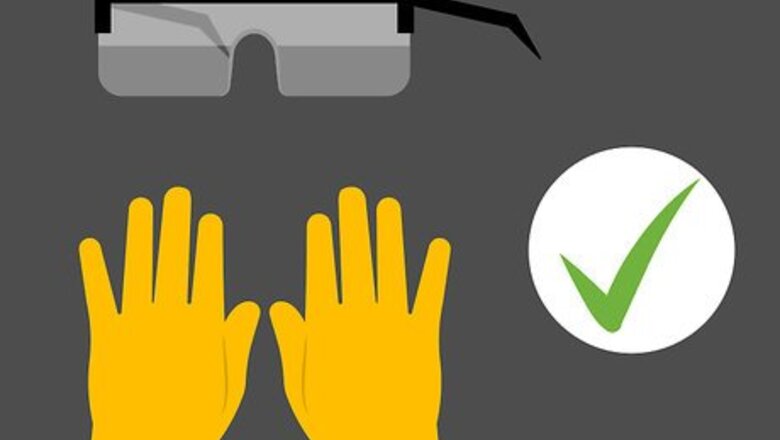
views
X
Research source
But even the best car batteries will run out of power eventually — or lose their charge prematurely when you leave your lights on too long. It can be a serious inconvenience to find yourself with a dead battery, but recharging one can require very little in terms of tools or mechanical experience.
Preparing to Charge the Battery
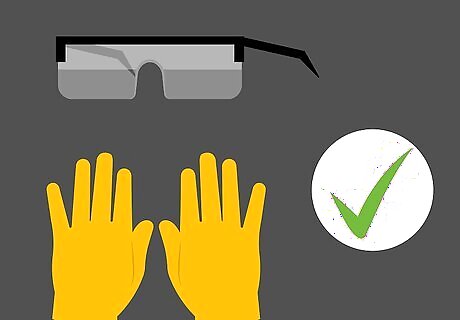
Put on the appropriate safety gear. Safety is paramount any time you are working on your vehicle. Start by putting on protective eyeglasses to protect you from any falling material under the hood of the car, sparks or battery fluid in the event the battery becomes compromised. You may also want to wear gloves. Make sure the area you are working in is well ventilated and lit sufficiently to allow you to see where you are going and what you are working on. Gloves are not necessary but may protect your hands from small pinches and cuts while working on your vehicle. Make sure there are no children in the area while you work on the battery of a vehicle as sparks could fly if positive and negative cables come into contact with one another.
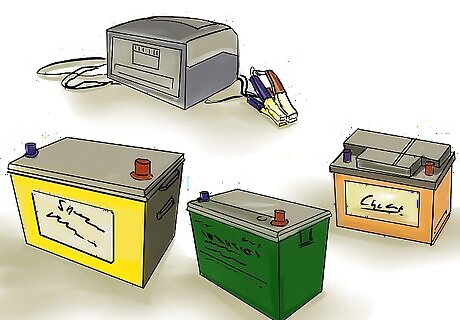
Determine what kind of battery you have. In order to properly charge your battery, you must first identify the type of battery you have. You can usually find this written somewhere on the battery, but you may need to check the manufacturer's website if the label is too worn to read or missing. You should also find out the voltage of the battery by looking on the battery’s label or by checking in your vehicle owner's manual. Types of batteries include: Wet cell batteries may be serviceable, which means there are things you can do to help improve the charge and the life of your battery. VRLA Batteries (Valve Regulated Lead-Acid Battery) are completely sealed and require no maintenance. These batteries come as Gel Cell or Absorbed Glass Mat batteries and are less common in cars unless purchased as an after-market modification.
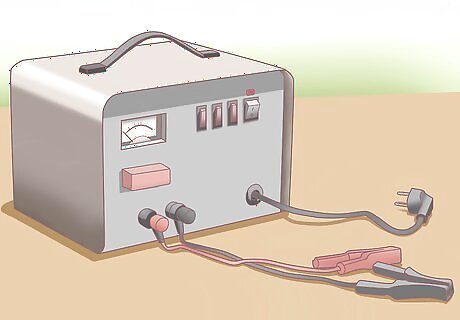
Get a car battery charger. Pick a charger that is appropriate for your battery and purposes. Most chargers will work for all types of batteries except Gel Cell batteries. There are fast chargers that can charge your battery quickly or even provide you with a jump start, as well as "trickle" chargers that provide a slow but longer lasting charge. Many newer chargers come with a microprocessor to monitor how much the battery has charged. These digital chargers will then stop the process automatically when the battery is fully charged. Older, simpler chargers must be stopped manually to prevent dangerous overcharging and should not be left alone for extended periods of time while connected. Read the charger's instruction manual to make sure you are using your particular unit correctly. Even new digital chargers should be monitored closely while charging to ensure it functions properly and stops before over-charging the battery.
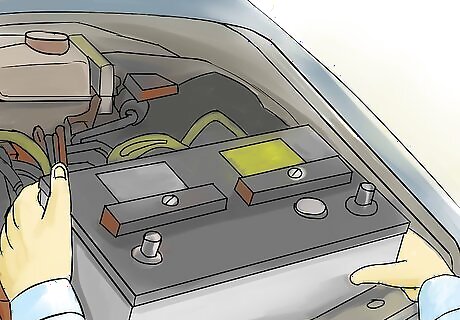
Disconnect and remove the battery from your vehicle if necessary. It’s important to disconnect the battery before conducting any repairs or maintenance on your vehicle. Most of the time you will be able to charge the battery without taking it out of the car, but if reaching the battery or fitting the charging cables in the engine bay or trunk where the battery is located proves difficult, remove the battery from the car completely while you charge it. If you are unsure where your battery is located, check the owner’s manual for your vehicle. Some vehicles have the battery in the trunk, while most have it under the hood. Disconnect the negative terminal first, then the positive when removing a battery.
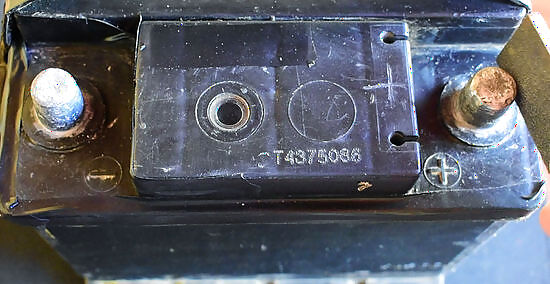
Clean the battery terminals. Any dirt or grime on the battery terminals can prevent the charging cables from establishing a strong connection to the battery, so it’s important to clean the terminals thoroughly. Use baking soda and a wet cloth or a sandpaper pad to wipe away any grime or rust. Make sure the terminals are bare metal before moving on to the next step in order to ensure a strong charge. Sometimes you may find the battery has a solid charge, but dirty terminals were preventing the electricity from flowing. Do not touch the terminals with your bare skin, especially if there is any white powder on them. This powder is usually dried sulfuric acid, and it can burn your skin if you come in contact with it.
Using a Speed or Trickle Charger
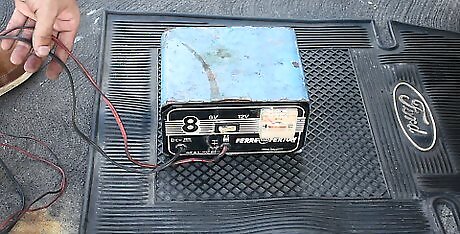
Place the charger on a stable surface. Never place the battery charger directly onto the battery as it may connect the negative and positive terminals, causing damage to the battery and charger and possibly even starting a fire. Instead, place the charger on a stable surface as far from the battery as the cables will allow. Before plugging the charger into the wall, ensure the area is well ventilated by opening your garage door or windows if you are indoors. Ensure the surface you place the charger on is sturdy and stationary to prevent it from falling or disconnecting from the battery. Use the full length of the cables to separate the battery from the charger as much as you can.
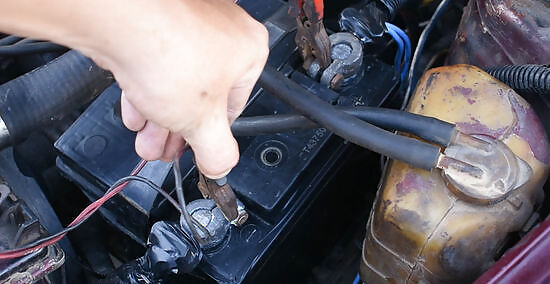
Connect the charger to the battery. Attach the black cable from the charger with the negative (-) sign on it to the negative terminal on the battery marked with the same symbol. Then attach the red cable with the positive (+) sign to the positive terminal on the battery with the corresponding symbol. Make sure to check the connections before plugging in or turning on the charger, as mixing the positive and negative terminals could result in damage to the battery or even a fire. Some cars may label the positive terminal with the letters POS instead of a positive (+) symbol and NEG instead of a negative (-) one. Ensure the cables are firmly attached to allow electricity to flow from the charger to the battery.
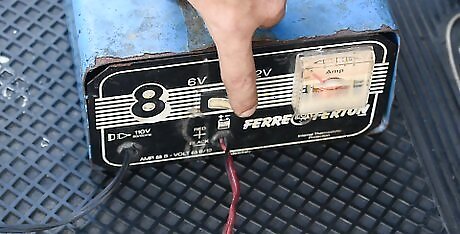
Set the charger. Digital chargers may indicate the existing voltage in the battery and allow you to set the final voltage level, while older models may simply allow for on and off settings. Speed chargers will also allow you to choose the speed in which you want to charge the battery (often depicted by a picture of a turtle for slow charges and a rabbit for fast ones). A fast charge is good for a car battery that recently died as a result of leaving your lights on or something to that effect, while a battery that has been dead for some time may require the slower charging method before the battery is usable again. If you can set the voltage the charger will stop on, set it to the specified voltage on the battery or that you found in the vehicle’s owner’s manual. Never set the charger to fast charge if you will be leaving the vehicle unattended. You may want to leave the battery slow charging overnight to fully charge it if it has been dead for some time.
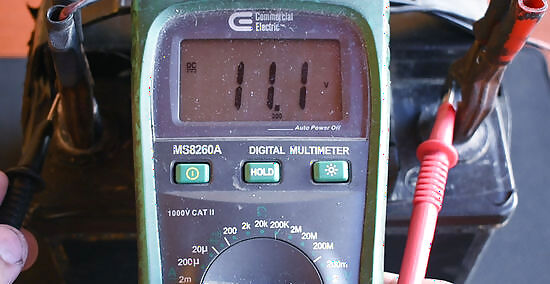
Check the battery. After allowing the battery to charge, check it to make sure it works. Some digital chargers will provide you with a readout that will tell you if the battery is properly holding the charge or if the battery will need to be replaced. This is often indicated by a percentage like “100%” as in the battery is 100% charged. You may also want to use a voltmeter to measure the voltage of the battery once disconnected from the charger by touching the positive and negative cables from the voltmeter to their respective terminals on the battery. If the battery is still in the car, the easiest way to check it might be to simply hook it up again and attempt to start the car. If the voltmeter reads the number of volts that are appropriate for the battery, the charger indicates it’s good, or the vehicle starts the battery is sufficiently charged. If the voltmeter or charger indicate that the battery is bad or the vehicle won’t start, there may be other issues to resolve or the battery may need to be replaced.
Jump Starting Your Battery
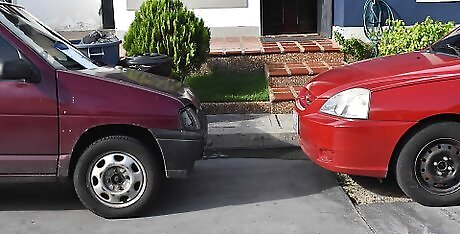
Park a functioning car so that it faces the car you’re jumping. Jump starting a vehicle involves using the electrical system of another running vehicle to charge the battery in yours sufficiently to allow it to start and charge itself. Before parking the functioning car, make sure you locate the battery in both vehicles, as some vehicle’s batteries can be found in the trunk. Once you have located the batteries in both vehicles, pull the running vehicle up to yours close enough so allow your jumper cables to connect both batteries. If the battery is in the trunk of one of the vehicles, back it up to the other so the cables can reach. Set the parking brake on both vehicles to ensure they don’t move during the charging process.
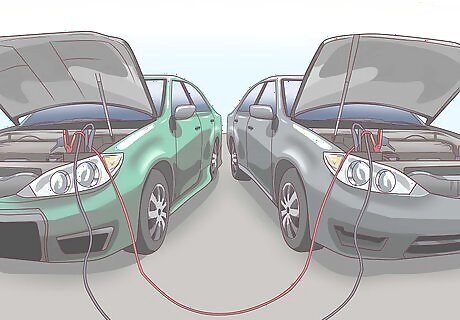
Use jumper cables to connect the two batteries. Remember that once you connect the jumper cables to a battery, touching the positive and negative ends of the other side of the cables will produce sparks that may be dangerous. With both cars shut off, connect the jumper cable to the positive terminal of the dead battery and then to the positive of the good battery. Be sure not to allow the negative cables to dangle into the engine bay where they may touch metal that could serve as a ground to complete the circuit. Next, connect the negative cable to the negative terminal of the dead battery, followed by the negative cable on the appropriate terminal of the good one. You may need to clean the terminals on both batteries to ensure a strong connection. Be sure you connect the positive ends to the positive terminals and the negative cables to the negative terminals. Mixing these up could result in damage or a fire.
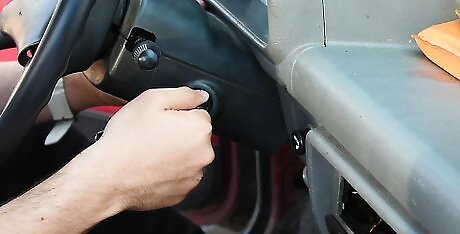
Start the functioning car. With the cables securely connected, start the functioning vehicle so its electrical system can begin charging the dead battery. Do not take the functioning vehicle out of park or neutral during the charging process. Allow the vehicle to run for a few minutes before attempting to start the other vehicle. After a minute or two, attempt to start the dead car. If the battery only died recently, it should start right up. If it doesn’t start after a minute or two, allow it to charge for a bit longer. If the battery has been dead for some time, it may take longer to charge it enough to start.
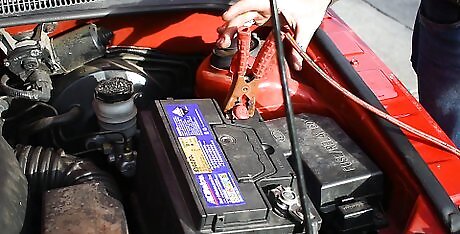
Disconnect the cables and allow the vehicle to run. Once the vehicle starts, you can disconnect the jumper cables from each vehicle. Allow the vehicle that had a dead battery to continue to run for a bit. You may have charged the battery enough to start the vehicle, but if you turn it off right away there may not be sufficient electricity to start it again. By letting it run, you give the vehicle’s alternator an opportunity to charge the battery the rest of the way. If the vehicle dies once again after it is disconnected from the other car, check to make sure the battery is securely connected. If the vehicle runs well, take it out for a short drive to thoroughly charge the battery before turning it off again.
Troubleshooting Battery Issues
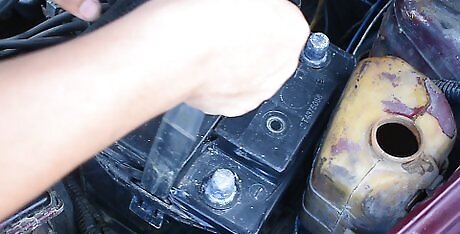
Have the battery checked by an auto-parts store. If you have charged the battery using a charger or another vehicle but your vehicle still won’t start, remove the battery (if you haven’t already) and take it to a local auto parts store. There, they can charge the battery and check to see if it works fine, can be serviced, or needs to be replaced. If your vehicle’s battery is a VRLA battery or a no-maintenance wet cell battery, you will have to replace it if it doesn’t hold a charge. If the battery is bad, you will need to purchase a replacement for it. If the battery is fully charged and working well but your car won’t start, check the battery cables to ensure they aren’t broken and connect firmly to the battery.
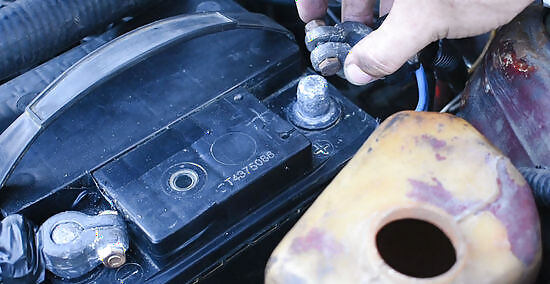
Test the alternator. A faulty alternator can prevent your vehicle from sufficiently charging the battery enough to start the car again and can even fail to produce enough electricity to keep the vehicle running. You can check to see if you have an issue with the alternator by starting the vehicle, then disconnecting the positive terminal of the battery. A properly functioning alternator will produce enough electricity to keep the vehicle running without the battery, but if the vehicle shuts off, the alternator likely needs to be replaced. You can sometimes tell if there is an issue with your alternator by looking at your interior lights. If the lights get brighter as you press on the gas pedal, then dim again when you remove your foot, the alternator may be bad. If you remove the alternator from your vehicle, many auto parts stores can test it to ensure it’s the problem before ordering a replacement.
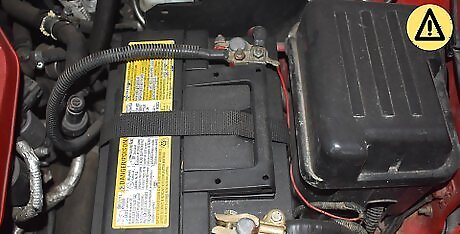
Listen for clicking. If the car won’t start, but produces audible clicking when you try, there likely isn’t enough electricity in the battery to start the vehicle. This may be because it failed to charge properly when you were charging it or it may be a result of the battery simply being too worn out to hold a charge. Try jump starting the car again, or remove the battery and have it tested. Make sure you have a good connection to the battery when charging it, otherwise the battery will not be able to start the car. The clicking indicates that there is some electricity in the battery, but not enough to start the engine.
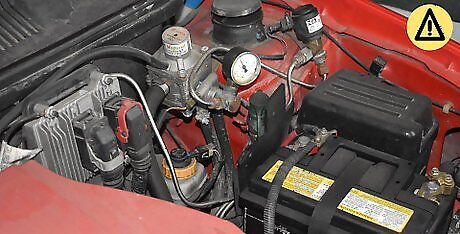
Take note if the vehicle stalls. If the vehicle starts after you charge the battery, but stalls soon after it starts to run, it may be because of the alternator. If it will start up again or it continues to crank but fails to start running however, the issue is not electrical. You may have an issue with fuel or air delivery. Your vehicle needs air, fuel and electricity to run properly. You will likely need to take the car to a mechanic to identify the issue if this occurs.




















Comments
0 comment